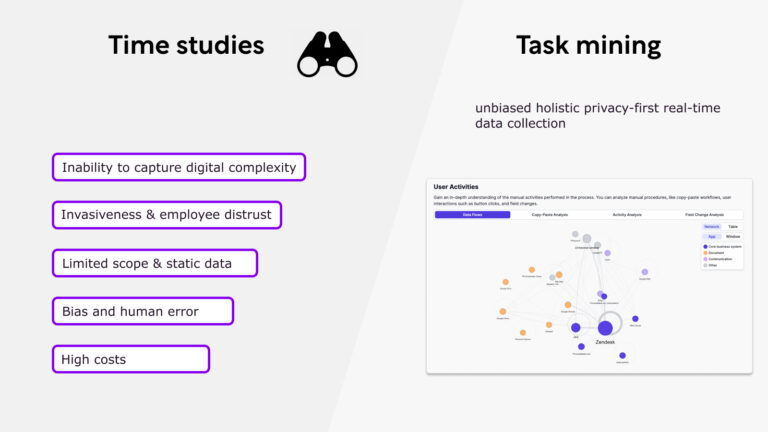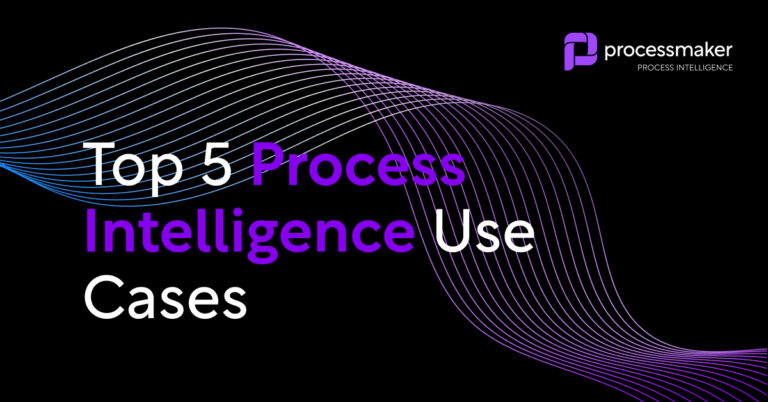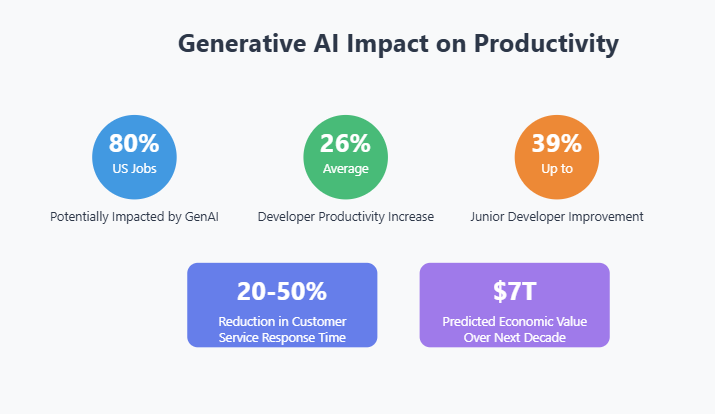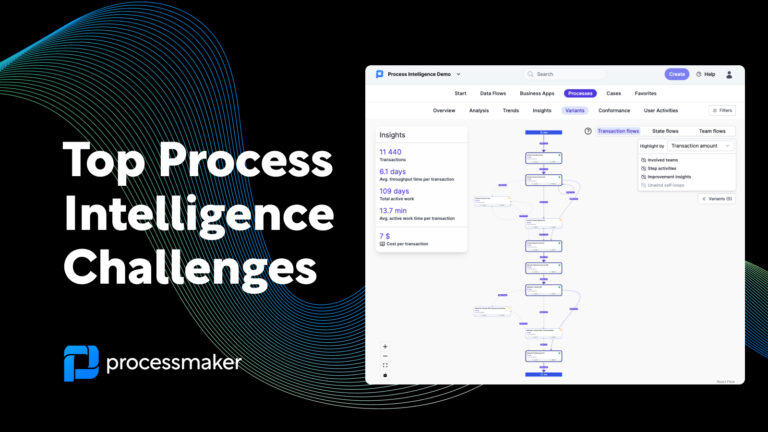For decades, organizations have relied on time studies to analyze employee productivity and improve efficiency. These traditional studies aim to measure how time is spent on tasks and identify opportunities for optimization. However, despite their long history, time studies have significant limitations. They are often seen as invasive, imprecise, and too static to provide actionable insights in the fast-evolving digital workplace.
So why do traditional time studies so often fail? Why should organizations consider task mining as a much better alternative?
The problem with traditional time studies
Time studies involve manual observation and data collection, often through surveys, time logs, or direct supervision. The goal is to find out how long employees take to complete certain tasks, what activities consume the most time, and how processes can be streamlined. While this approach has provided useful insights in specific contexts, it falls short in today’s complex, digital work environment.
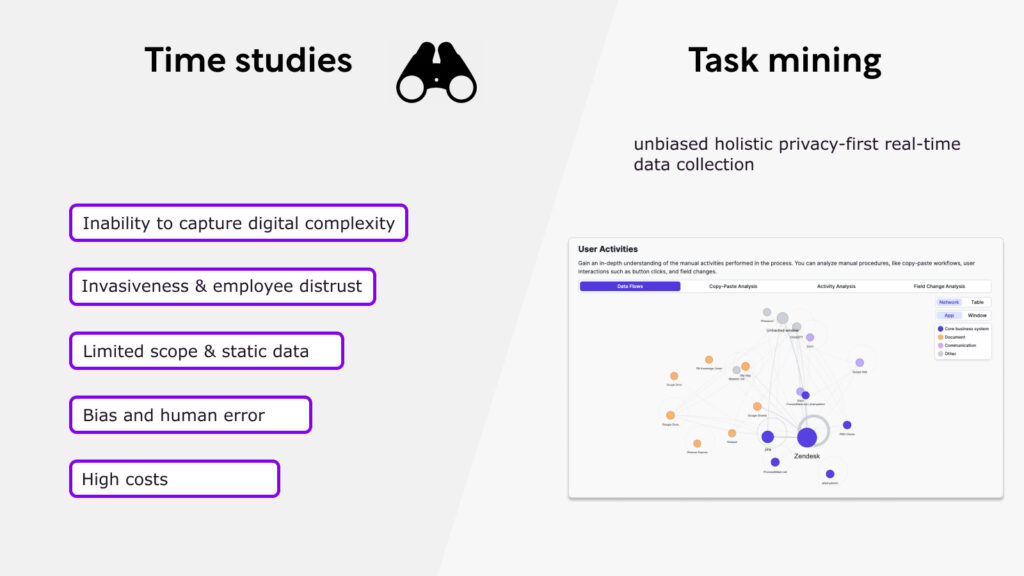
Here are the key reasons why traditional work/time studies frequently fail:
1. Invasiveness and employee distrust
Time studies often require direct observation or employee self-reporting. This creates an environment where employees feel scrutinized and distrusted, leading to anxiety and even resistance. Workers might modify their behavior to meet perceived expectations, a phenomenon known as the Hawthorne Effect, making the collected data unreliable. When employees feel their every move is monitored, it can hinder productivity instead of boosting it.
2. Limited scope and static data
Traditional time studies offer only a snapshot of how work is done at a particular moment. They lack the depth and continuity to capture evolving workflows, changes in technology, or fluctuating workloads. For example, a study may analyze employee performance for a week, but it won’t account for seasonal peaks, special projects, or system upgrades. This static nature of work/time studies often leads to recommendations that become obsolete quickly.
3. Bias and human error
Self-reported data and manual observations are prone to bias and inaccuracies. Employees might intentionally or unintentionally misreport their time usage, and observers may bring their own biases into the analysis. This introduces inaccuracies and can lead to misguided decisions based on faulty data. Additionally, work/time studies focus primarily on the duration of tasks, rather than the quality or efficiency of the process, which limits their utility.
4. Costs
Conducting a comprehensive time study is resource-intensive, requiring significant time, manpower, and capital investment. For large organizations, observing and analyzing every role or department can be logistically overwhelming. And by the time the study is complete, the data may no longer reflect the current state of work.
5. Inability to capture digital complexity
Modern work involves a complex interplay between multiple applications, systems, and communication tools. Time studies struggle to keep up with this digital complexity. The manual tracking methods used in traditional studies cannot accurately capture how employees switch between apps, collaborate in real time, or handle digital tasks.
Process intelligence: a modern solution for understanding workflows
Enter process intelligence, a new approach to analyzing workflows digitally and automatically. Unlike traditional time studies, process intelligence captures granular data about how work is done across digital environments. This involves tracking user interactions with desktop and web applications, allowing for an unbiased and comprehensive understanding of tasks and processes, while not undermining privacy and security concerns.
Process intelligence brings together the power of task mining and process mining technologies, and here’s why it is a game-changer for organizations:
1. Unbiased, automated data collection
Process intelligence tools like task mining operate passively, collecting data on user interactions without the need for intrusive observation or manual logging. This means employees aren’t aware of the monitoring, leading to more genuine behavior and unbiased data. As a result, organizations can rely on data that accurately reflects how work is done, eliminating the pitfalls of bias and human error.
2. A holistic view of digital workflows
In the modern workplace, employees use a wide range of tools and applications to perform tasks. Smaller organizations use 112 different SaaS apps on average, while for bigger enterprises that number may reach up to 200 different tools.
Task Mining captures this complexity by tracking interactions across all applications, including ERPs, CRMs, web portals, communication tools, and more. This gives organizations a holistic view of workflows, allowing them to identify manual work and inefficiencies that traditional time studies might overlook.
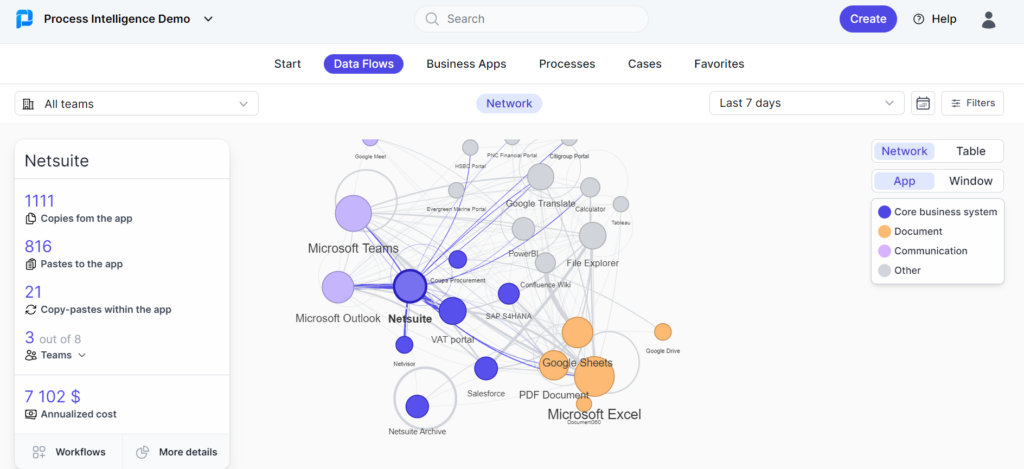
A screenshot from a task mining software by ProcessMaker: the tool captures interactions and data points across different systems, teams, and applications.
3. Continuous monitoring and real-time insights
Unlike traditional studies, which provide only a static snapshot, task mining enables continuous monitoring of employee activities. This allows organizations to gain real-time insights into evolving workflows, changing workloads, and the impact of new tools or processes. Task mining tools can automatically flag bottlenecks, process deviations, or compliance issues, allowing organizations to take immediate corrective action.
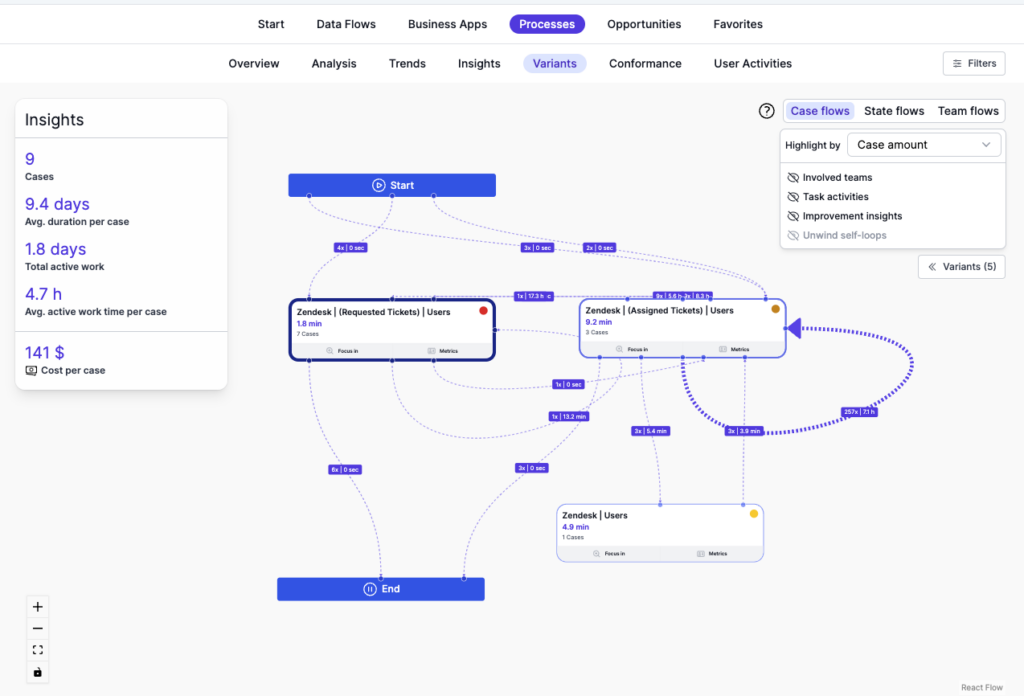
A screenshot from a task mining software by ProcessMaker: the tool shows different variants of the tracked processes, revealing inefficiencies and bottlenecks.
4. Privacy and security
Employees often experience distrust when closely observed by external parties during time studies, leading to stress and concerns about privacy violations. In contrast, data collection through task mining eliminates the presence of human observers. This method focuses exclusively on whitelisted (and agreed upon) business applications and does not involve personal usage of tools like WhatsApp or Facebook. As a result, employees can feel reassured knowing that the process intelligence tool is SOC- and GDPR-compliant, ensuring that no personal information is collected.
5. Actionable metrics and KPIs
Task mining goes beyond measuring task durations. It captures a range of KPIs, including error rates, process adherence, and application usage, giving organizations a deeper understanding of efficiency. For example, it can reveal if employees are spending excessive time switching between applications or if communication delays are impacting productivity. This leads to more targeted recommendations and effective process improvements.
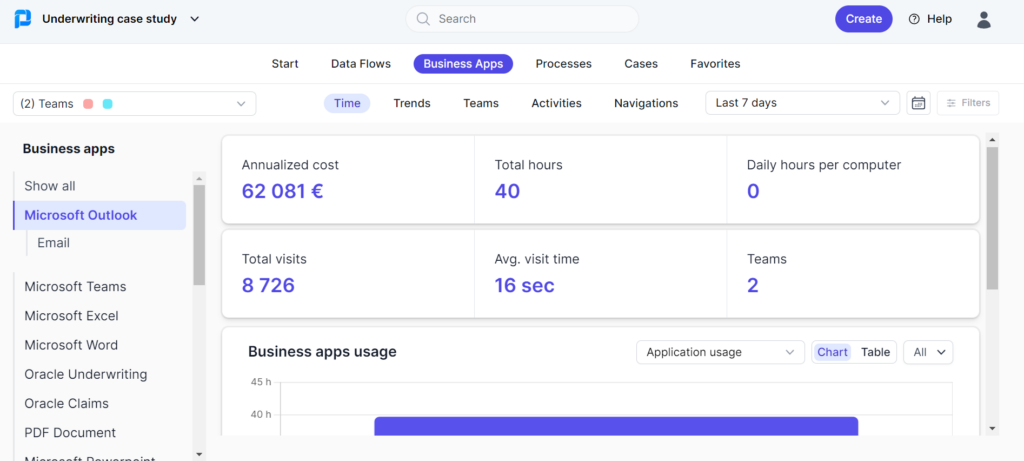
A screenshot from a task mining software by ProcessMaker: examples of metrics and KPIs collected by the software.
6. Scalability and cost-Efficiency
Task mining tools are scalable, making them suitable for organizations of all sizes. They can be deployed across departments, roles, and locations without the need for a massive upfront investment. Additionally, task mining reduces the need for extensive manual observation, lowering costs and freeing up resources for other strategic initiatives.
Real-world application: from data to decisions
Imagine a scenario where a company wants to optimize its customer support operations. Traditionally, they would conduct a time study, sending observers to watch how agents handle support tickets, or relying on agents to log their time. This could take weeks, cost thousands of dollars, and provide only a limited understanding of what’s happening.
With task mining, the company could deploy a digital solution that automatically tracks how agents navigate between their CRM, email, and chat tools. It would capture the time spent on each task, identify repetitive steps, and reveal any communication delays between teams. By analyzing this data, the company could streamline workflows, automate repetitive actions, and optimize collaboration channels.
Conclusion
While traditional time studies have served a purpose in the past, they are no longer sufficient in today’s complex digital workplace. The limitations of manual observation, employee distrust, and static data make work/time studies a poor fit for modern organizations. Task mining, on the other hand, offers a powerful alternative that leverages automation, real-time insights, and holistic data collection.
By adopting task mining, organizations can gain a clear and unbiased view of how work is done, identify inefficiencies, and drive meaningful process improvements. It’s a modern solution for a modern workplace, enabling businesses to adapt quickly, optimize workflows, and remain competitive in an ever-changing digital landscape. Task mining isn’t just a replacement for time studies—it’s a game-changer for how organizations understand and improve their operations.
